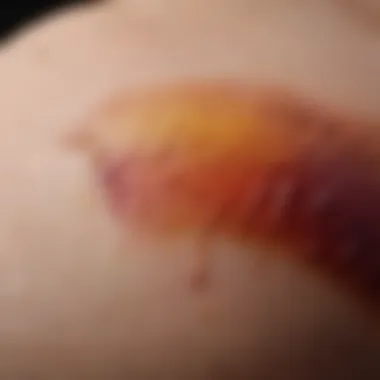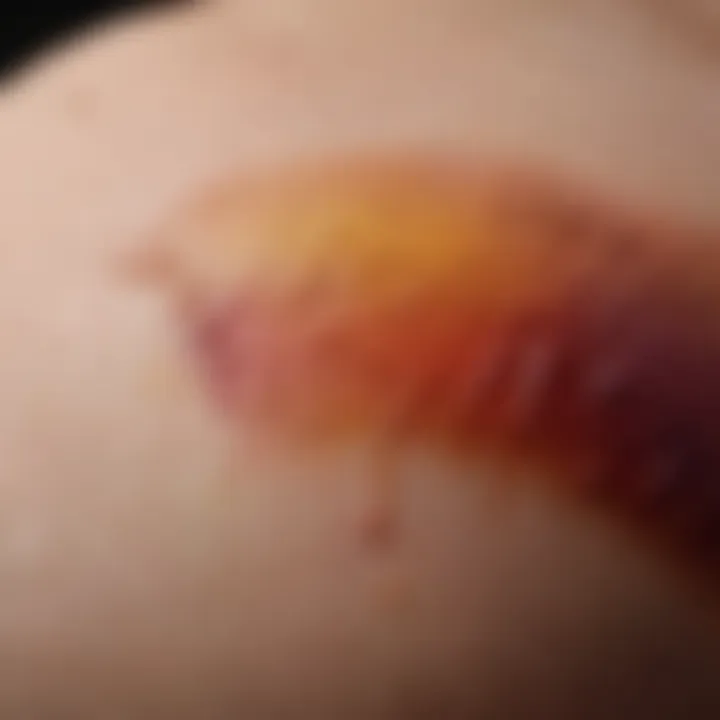Understanding Easy Bruising: Causes and Implications


Intro
Easy bruising may seem like a trivial inconvenience, but for many individuals, it can signal deeper health concerns. Some people might notice that they acquire a bruise from an almost imperceptible bump, while others might hardly bruise at all regardless of their activity level. This disparity raises questions about the mechanisms behind bruising and highlights the need for understanding what lies beneath the surface.
Easy bruising can be caused by various factors, ranging from genetic predispositions to underlying medical conditions. While common sense might suggest that age or lifestyle choices play a significant role, recent discussions hint at several intricate physiological processes that contribute to an individual's susceptibility to bruising.
As we explore the framework of easy bruising, we will delve into the roots of this phenomenon and consider both the biological and lifestyle elements at play. Don't worry, we'll cover plenty of colorful terms to ensure you leave with a well-rounded grasp of the subject! So, let’s get right into it.
Intro to Easy Bruising
Understanding easy bruising is not just a fleeting concern; it’s a pressing topic that intersects health, aesthetics, and personal well-being. Bruising, the visible manifestation of trauma beneath our skin, often raises eyebrows, prompting people to ask why some seem to acquire bruises at the drop of a hat while others remain unscathed. This article sheds light on the significance of easy bruising by delving into its many facets—physiological, genetic, lifestyle, and medical conditions—that influence this condition.
Defining Easy Bruising
Easy bruising is defined as a tendency to develop bruises more readily than the general population. Essentially, it is when small injuries that may go unnoticed lead to noticeable discoloration of the skin. For instance, an individual might bump into a chair and soon after discover a tender, purple mark where none had previously existed. Many variables can contribute to easy bruising, making it essential for us to explore its underlying mechanisms and implications.
In essence, the causes of easy bruising can range from the benign—such as minor injuries or genetic predisposition—to the serious, including various medical conditions. Understanding these nuances allows individuals to navigate their health more effectively, seeking medical advice when required, while also making informed decisions regarding skin care and personal safety.
Societal Perceptions of Bruising
Societal perceptions around bruising are often steeped in assumptions. Many view bruises as signs of carelessness or physical altercations, leading to stigmas that can affect mental well-being. The truth, however, is far more complex. The societal lens often overlooks the medical and genetic roots of this phenomenon. When someone reveals them-selves to be prone to bruising, it can sometimes elicit unwarranted judgments—labeling them as overly fragile or clumsy.
Such perceptions can provoke a cycle of embarrassment, where individuals feel compelled to downplay or hide their bruises, possibly exacerbating feelings of insecurity about their physical appearance. This dynamic underscores the importance of education, as a better understanding of what causes easy bruising can foster compassion and acceptance in social circles.
Ending of the Section
In summary, the introduction of easy bruising sets the stage for a deeper exploration into its causes and implications. By challenging preconceived notions and shedding light on the physiological and societal factors at play, readers can foster a greater understanding of why easy bruising occurs and how to address it holistically.
Physiology of Bruising
Bruising might seem like a simple, everyday occurrence, but it houses complex physiological processes beneath the surface. Understanding the physiology of bruising is key in grasping why some individuals are more susceptible to it than others. This section sheds light on the intricate dance between various components within our body—like blood vessels, platelets, and the healing mechanisms—that contribute to the formation of bruises.
Understanding Blood Vessels
Blood vessels play an important role in the battle against bruising. Our body comprises various types of vessels—arteries, veins, and capillaries—each serving a unique function. Capillaries, in particular, are the tiniest blood vessels but hold significant sway in the context of bruising. When these small vessels are damaged due to an impact, they can leak blood into the surrounding tissue, leading to the characteristic discoloration associated with bruises.
Imagine walking into a doorframe; the impact might not seem too harsh, yet it's enough to rupture those fragile capillaries. The blood that seeps out creates a spectrum of colors on the skin, turning from red to purple, and eventually fading to a light yellow as it heals. This whole process highlights how sensitive our vessels can be, and for some people, everyday activities can inadvertently lead to such injuries.
The Role of Platelets in Bruising
Platelets, or thrombocytes, are another key player in the bruising saga. When a blood vessel is injured, the body sends platelets to the scene like tiny repair workers. These cells aggregate at the injury site, creating a plug to minimize blood loss. Their quick response is vital during the initial swift phase after an injury occurs.
However, not all platelets perform equally well. In some cases, genetic predispositions may result in a lowered platelet count or impaired functionality, which could increase the likelihood of bruising. Individuals may find themselves sporting more bruises than the average person not because of lifestyle choices, but due to their body's unique response mechanisms. Thus, understanding the nuances of platelet function adds another layer to our knowledge of why bruising occurs.
Healing Process Explained
Healing from a bruise isn't just about time; it involves several physiological stages. Initially, after a bruise forms, the body activates its inflammatory response. This is often characterized by swelling, tenderness, and other signs that signal the body is working to repair the damaged tissue. The inflammatory stage typically lasts a few days, followed by a stabilization phase where the body begins to break down and reabsorb the blood that leaked into the tissue.
As the bruise matures, the colors transition from dark purples to greens and yellows. This change is due to the breakdown of hemoglobin, the protein in red blood cells that carries oxygen. The body reabsorbs byproducts of this process, ultimately leading to resolution. While this phenomenon may seem like a nuisance, it's an essential part of healing.
In summary, the physiology of bruising involves a delicate interplay between blood vessels, platelets, and a multi-phase healing process. By appreciating these components, individuals can gain insights into why some people could be more prone to bruising than others—knowledge that can help in managing and perhaps even preventing excessive bruising in the future.
Understanding the mechanics of bruising not only demystifies its occurrence but also empowers individuals to recognize their body's responses effectively.
Genetic Factors and Predisposition
Understanding how genetics can play into an individual’s tendency to bruise easily reveals a lot about the complexities of our health. Easy bruising may not just be a passing annoyance; it can serve as a window into one’s genetic background. When digging deep into this topic, we discover a layered perspective that encompasses various hereditary conditions that might pave the way for increased bruising risk, alongside the role family history plays in this matter.
Hereditary Conditions Linked to Bruising


Some hereditary conditions can lead to vulnerabilities that make bruising more likely to occur. For instance, Ehlers-Danlos syndrome, a connective tissue disorder, presents with hyper-elastic skin and may also cause bruising with minimal impact. Those who bear this condition often find that their blood vessels are less resilient, making them susceptible to damage from seemingly trivial activities.
Another example is von Willebrand disease, which significantly impacts the blood’s ability to clot properly. This condition raises red flags for those who might experience frequent bruising. Those affected often have to navigate their daily routines with a keen eye for safety, as even light activities can lead to bruising episodes.
Moreover, hemophilia is another hereditary condition where individuals lack specific clotting factors, leading to difficulty in stopping bleeding. Bruising, in this context, is not just a cosmetic issue but a serious health concern, requiring constant vigilance.
It’s crucial for those with a family history or suspected genetic conditions to seek proper testing and medical advice, as knowing the underlying condition allows for better management of symptoms and lifestyle adjustments.
Family History Considerations
When it comes to bruising, your family history isn't just background noise—it's a loudspeaker that might echo potential risks. If easy bruising runs in the family, there could be a deeper genetic thread at play. Analyzing family patterns can illuminate potential hereditary syndromes or traits that predispose certain members to bleeding or bruising easily.
Behavioral patterns within families can also factor in. For instance, a family that enjoys physical activities may inadvertently create an environment where light bruising becomes a common occurrence. It’s worth considering whether certain habits or activities might be linked to genetic predispositions, which can light a path to preventive measures to maintain skin integrity.
Furthermore, recognizing and discussing family history can facilitate better healthcare assessments. Family members can collectively share insights, possibly identifying trends that a solo case might overlook.
Highlighting one's own bruising tendencies, alongside those of family members, can provide valuable context. It might just connect the dots between genetic predispositions and observable traits in an engaging conversation with a healthcare provider.
Understanding the genetic factors at play empowers individuals to advocate for their health and make informed decisions.
In summary, the connection between genetics and bruising is multifaceted. Genetic factors can provide clues about one’s susceptibility to easy bruising, and family histories can support better health outcomes by facilitating discussions with healthcare professionals. By recognizing these aspects, individuals can take proactive steps towards managing their health effectively.
Medical Conditions Associated with Easy Bruising
Understanding the connection between various medical conditions and easy bruising serves as a crucial pillar in grasping why certain individuals might find themselves more prone to this phenomenon. Easy bruising can often be more than just a mere annoyance; it is frequently a sign that the body is grappling with underlying health issues. Being aware of these conditions can not only enhance individuals' knowledge but it can also empower them to seek appropriate medical advice when necessary. Recognizing the interplay between health conditions and bruising is an essential part of understanding one's overall well-being.
Blood Disorders and Their Impact
Blood disorders, in various forms, can significantly elevate the risk of easy bruising. Two main types of blood disorders come to mind: clotting disorders and thrombocytopenia. Clotting disorders occur when the proteins in blood responsible for controlling bleeding are absent or function improperly. For instance, Hemophilia, which is often recognized from childhood, leads to prolonged bleeding episodes and increased bruising because the blood does not clot as it should.
Thrombocytopenia, characterized by a low platelet count, can arise from several conditions, such as autoimmune disorders or certain infections. Platelets are like the body’s little first responders; without enough of them, there's a real increase in bruising with even minor impacts.
"Increased bruising can often signal a deeper issue, laying the groundwork for potential complications if left unaddressed."
Understanding these blood disorders isn’t just about knowing the technical terms; it is vital for those who experience frequent bruising to consider these underlying issues and discuss them with healthcare providers.
Liver Disease and Bruising Risks
Liver health is oftentimes an overlooked aspect when assessing easy bruising. The liver plays a pivotal role in producing proteins that facilitate clotting. When liver function declines, whether due to cirrhosis, hepatitis, or fatty liver disease, the body’s ability to withstand and recover from even mild trauma can suffer. Patients experiencing liver disease may find that they bruise easier, and these bruises may take longer to heal.
Moreover, the liver helps manage the levels of vitamin K in the body, a nutrient essential for clotting. A lack of this vitamin can lead to excessive bruising and bleeding, showcasing the liver's important role in maintaining healthy blood functions.
Vitamin Deficiencies and Impact
The link between vitamin deficiencies and easy bruising is significant, particularly concerning vitamin C and vitamin K. A deficiency in vitamin C can lead to weaken connective tissues, creating an environment where capillaries are more prone to breakage even under minor stress, leading to bruises. Additionally, vitamin K is crucial for effective clotting; without adequate levels, minor injuries can quickly translate into conspicuous bruises.
Eating a balanced diet rich in fruits, vegetables, and healthy oils can mitigate these deficiencies. Some might overlook the dietary angle, but it plays a foundational role in skin health and the body's restorative capabilities. Knowing which vitamins help maintain skin strength and resilience against bruising can positively impact long-term skin care strategies and improve overall health.
The End
The understanding of how different medical conditions, from blood disorders to liver diseases, and vitamin deficiencies contribute to easy bruising emphasizes the need for a proactive approach to personal health. Awareness can be a game changer for individuals who find themselves frequently bruising without a clear reason. It provides a pathway to better management and prevention strategies, reinforcing that caring for one’s health goes hand in hand with caring for one’s skin and appearance.
Lifestyle Factors Contributing to Bruising
Lifestyle choices play a crucial role in shaping how our bodies respond to everyday activities, including susceptibility to bruising. Bruises can often be a sign of an underlying concern, but they can also surface due to the way we live our lives. By understanding various lifestyle factors, one can take proactive steps to minimize their occurrence. Here we will examine dietary influences, alcohol consumption, and the impact of physical activity on bruising.
Dietary Influences on Bruising
Diet significantly impacts skin health and the body’s ability to heal itself. Foods rich in vitamins, especially Vitamin C and K, are essential for maintaining healthy blood vessels and facilitating the healing process.
A lack of Vitamin C can lead to weakened capillaries, making the skin more prone to bruises. Good sources of Vitamin C include:


- Oranges
- Strawberries
- Bell peppers
- Kale
Similarly, Vitamin K plays a vital role in blood clotting, which is crucial for minimizing bruises. Foods rich in Vitamin K include:
- Spinach
- Broccoli
- Brussels sprouts
Incorporating these foods into your daily meals can aid in preventing easy bruising. Hydration is another critical element; ensuring adequate water intake helps maintain skin elasticity and overall vascular health. When the body is well-hydrated, the skin appears healthier and benefits from improved nutrient delivery through blood flow.
Alcohol Consumption and Its Effects
When it comes to bruising, alcohol can be a double-edged sword. Moderate consumption may not be significantly harmful, but excessive drinking has been linked to an increased risk of bruising. Alcohol affects platelet function and can dilute essential nutrients in the bloodstream.
For those who indulge regularly, blood-thinning effects can make it easier to bruise from minor impacts. Furthermore, alcohol can impact liver function, which is vital for processing various substances including vitamin storage that supports overall skin and vessel integrity. Being mindful of alcohol consumption is important—strategies like setting limits on how much you drink or opting for non-alcoholic beverages during social events can help manage the risk.
The Role of Physical Activity
Physical activity has numerous benefits, including enhancing blood flow and improving skin tone, but not all exercises are created equal when it comes to bruising.
High-impact sports or those that involve close contact, such as rugby or martial arts, can naturally result in more bruising due to increased risk of falls or bumps. However, a balanced exercise routine that includes strength training, cardiovascular workouts, and flexibility exercises can boost overall skin resilience.
- Weight training can strengthen muscles and tissues surrounding blood vessels, which might make them less likely to get damaged.
- Gentle stretching can improve circulation and may prevent vascular injuries that lead to bruising.
Importantly, warming up and cooling down properly fosters muscle and vessel health, paving the way for a more stable body. So, incorporating a well-rounded fitness regime is not just good for your shape, but also for your skin.
"A penny for your thoughts! Remember, every bruise tells a story; it often reflects how we treat our bodies and what we put into it."
Understanding these lifestyle factors can lead to better skin health and resilience, decreasing the chances of experiencing easy bruising.
Medications and Supplements Impacting Bruising
Understanding the role that various medications and dietary supplements play in bruising can offer valuable insights for those who experience excessive or easy bruising. It's akin to uncovering the hidden layers beneath the surface—much like exploring a new facet of skincare that can either exacerbate or alleviate skin issues. As individuals seek remedies or preventative strategies, it becomes crucial to recognize how these substances interact with the body's natural processes.
Common Medications Linked to Bruising
A cocktail of medications may influence an individual's tendency to bruise easily, often without the user being aware of the implications. Certain drugs thin the blood or alter the body's natural healing mechanisms, making bruising more prevalent. Here are some common culprits:
- Aspirin: This widely used over-the-counter pain reliever is known to inhibit platelet aggregation, which can lead to increased bleeding and subsequent bruising.
- Warfarin: Often prescribed as an anticoagulant, Warfarin can significantly affect clotting factors and enhance bruising risk. Patients must monitor their intake closely.
- Heparin: Employed in hospitals for its blood-thinning properties, this medication could lead to larger bruises and hematomas in certain cases.
- Corticosteroids: Medical professionals might prescribe these to manage inflammation or auto-immune conditions. However, they can weaken blood vessel walls, amplifying the chance of bruising.
Recognizing the connection between these medications and bruising transforms awareness into action. Consulting a healthcare provider to discuss alternative options or dosage adjustments can help mitigate this issue.
Supplements and Their Effects
Supplements, while often viewed as benign or beneficial, can also affect bruising tendencies. Many individuals turn to these from a perspective of health improvement, but some can have unintended consequences:
- Fish Oil: Known for its heart health benefits, fish oil can also have anticoagulant properties, which might lead to increased bleeding.
- Ginkgo Biloba: This herbal supplement may improve memory and circulation but tends to have blood-thinning effects, which can amplify bruising.
- Vitamin E: While praised for skin health, high doses of Vitamin E can interfere with blood clotting, leading to a higher likelihood of bruising.
- Glucosamine: Often used to support joint health, glucosamine has been linked to an increased risk of bleeding in some cases.
It's wise for individuals to consider a balanced approach when taking supplements. Best practices would include monitoring intake and discussing any health changes with medical professionals.
It is essential to approach medications and supplements as more than mere tools for health. Their influence on bruising prevalence reminds us that a comprehensive view matters in maintaining overall well-being.
Preventive Strategies to Minimize Bruising
Easy bruising can be more than a mere inconvenience; it often indicates underlying issues that warrant attention. Therefore, adopting preventive strategies to minimize bruising is not just prudent but essential for some. Implementing effective strategies can greatly enhance skin resilience and overall well-being, allowing individuals to enjoy an active lifestyle without the looming concern of unsightly marks. Understanding the interplay of nutrition, skin care, and routine check-ups can empower individuals in managing and potentially reducing their susceptibility to bruising.
Dietary Adjustments for Better Skin Health
Nutrition is the cornerstone of healthy skin. A well-balanced diet can remarkably strengthen blood vessels and support skin integrity, thereby minimizing bruising risks. Essential vitamins such as Vitamin C and Vitamin K can be particularly beneficial. Vitamin C aids in collagen production, strengthening the skin and blood vessels, while Vitamin K is pivotal in blood clotting, reducing the chances of easy bruising.
Foods rich in Vitamin C:


- Citrus fruits (oranges, grapefruits)
- Bell peppers
- Strawberries
- Broccoli
Foods high in Vitamin K:
- Leafy greens (spinach, kale)
- Brussels sprouts
- Green beans
- Avocado
Staying hydrated is another critical factor; drinking adequate amounts of water helps maintain skin elasticity. Moreover, incorporating omega-3 fatty acids, found in fish and flaxseeds, may reduce inflammation, which can further contribute to bruising.
Skin Care Practices for Enhanced Resilience
How we care for our skin can also play a pivotal role in its resilience. Gentle skin care routines can prevent injury to blood vessels and minimize the occurrence of bruises. Opting for a mild cleanser and avoiding harsh exfoliators is wise, as excessive scrubbing can damage the skin layer.
Applying moisturizers regularly creates a protective barrier, keeping the skin from becoming dry and fragile. Ingredients to look for include:
- Hyaluronic acid
- Glycerin
- Ceramides
In addition to moisturizing, sun protection cannot be overlooked. Ultraviolet rays can weaken skin structure over time, making it more prone to bruising. Daily application of sunscreen, even on cloudy days, is crucial. Choose broad-spectrum protection with at least SPF 30.
"The skin is the body's largest organ and must be treated with care; protecting it can prevent bruising and enhance overall health."
Importance of Regular Check-Ups
Routine medical check-ups are often undervalued in everyday life. For those prone to bruising easily, engaging with a healthcare professional regularly can help catch any underlying concerns early. It is prudent to discuss any noticeable changes with a doctor, as they may indicate problems with blood coagulation or other health issues. Early diagnosis can allow for timely interventions.
Moreover, specialists may recommend blood tests to explore factors like platelet levels, which can help pinpoint issues contributing to a tendency to bruise more easily. Regular consultations enable a better understanding of one’s health status and the development of tailored strategies aimed at reducing bruising susceptibility.
When to Consult a Healthcare Professional
Understanding when to reach out to a healthcare professional regarding easy bruising is paramount. While occasional bruises can be part of daily life, consistent bruising or bruising without clear cause tends to raise red flags. This section outlines important aspects related to when you should seek medical advice, the benefits of doing so, and considerations that may influence your decisions about consulting a healthcare provider.
Warning Signs to Note
Not all bruising warrants immediate concern, but several signs should prompt a visit to a healthcare professional:
- Frequent Bruising: If you're bruising more often than usual without engaging in activities that typically cause bruises, it's worth investigating.
- Large or Unusual Bruises: Bruises that are particularly large or those that appear in unusual areas, especially if they develop rapidly, may indicate underlying issues.
- Bruising Accompanied by Other Symptoms: Signs such as pain, swelling, or discoloration around the bruise, or systemic symptoms like fever and fatigue can suggest a more serious condition.
- Family History of Bleeding Disorders: A family history of conditions that affect clotting may also warrant an evaluation.
- Notable Changes in Bruising Patterns: Any abrupt changes in how bruises appear or how quickly they heal can be concerning.
It's essential to pay attention to your body and recognize patterns. Listening to these warning signs is crucial – they might not just be a reflection of your lifestyle, but indicators of a deeper issue.
What to Expect During a Consultation
Visiting a healthcare professional for bruising can sometimes feel daunting. However, understanding what to expect can alleviate some anxiety and help you prepare for a productive discussion. Here's what typically happens during a consultation about easy bruising:
- Medical History Review: Your doctor will likely start with questions about your medical history, including any known conditions, family medical history, and recent medications.
- Physical Examination: Expect a thorough examination of your bruises, as well as general health assessments. The doctor may palpate areas where bruises have formed to assess tenderness and swelling.
- Diagnostic Tests: Depending on findings, your doctor might recommend blood tests to check for clotting issues, platelet counts, or other blood-related concerns. In some cases, imaging studies may be warranted to rule out injuries hidden beneath the skin.
- Discussion of Findings: After tests, your doctor will discuss findings and suggest potential treatment options, lifestyle changes, or further evaluations if necessary.
- Follow-Up Appointments: If a medical condition is identified, follow-up visits might be set up to monitor your situation over time or to manage treatments effectively.
Seeking timely advice can lead to early detection of conditions that may require treatment, making it vital to act based on observed symptoms.
Being proactive about health concerns illustrates an understanding of your body and ensures that underlying issues receive appropriate attention.
Culmination: The Multifaceted Nature of Bruising
Understanding easy bruising is not just about acknowledging its existence; it's about recognizing the myriad factors that contribute to it. This conclusion wraps up the elaborate discussion we’ve had throughout the article on the causes, implications, and prevention strategies associated with the phenomenon of easy bruising. It's clear that bruising can stem from a blend of genetic, medical, and lifestyle factors, making it a complex issue rather than a simple one.
Summarizing Key Takeaways
As we've explored, there are several key takeaways that stand out. Firstly, the body's physiology plays a primary role—understanding how blood vessels function and how platelets aid in clotting is crucial. The connections to medical conditions, such as blood disorders and liver diseases, further highlight the need for individuals to remain vigilant about their health.
When it comes to lifestyle, dietary choices, alcohol consumption, and physical activity all contribute significantly to one's susceptibility to bruising. It’s vital to recognize that everyday habits can have unforeseen repercussions, leading to increased bruisability.
"Easy bruising can serve as a window into one’s overall health, often revealing underlying medical issues that may not be immediately apparent."
Monitoring one's health, especially if bruises appear frequently and without a clear cause, is essential. Regular check-ups with healthcare professionals can uncover potential deficiencies or disorders, guiding individuals toward appropriate treatment.
Future Research Directions
Looking ahead, future research could delve deeper into the genetic bases of easy bruising. Investigating specific genes that may predispose individuals to this condition could greatly enhance our understanding and therapeutic approaches. Additionally, studying the impact of emerging supplements and alternative treatments on bruising could provide new insights for those affected.
Furthermore, we should also see more comprehensive studies aimed at determining the link between various medications and their long-term effects on bruisability. Understanding the intricate balance between necessity for medication and the side effects that come along with it is crucial.







